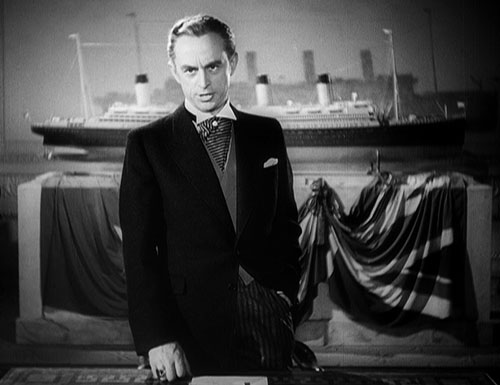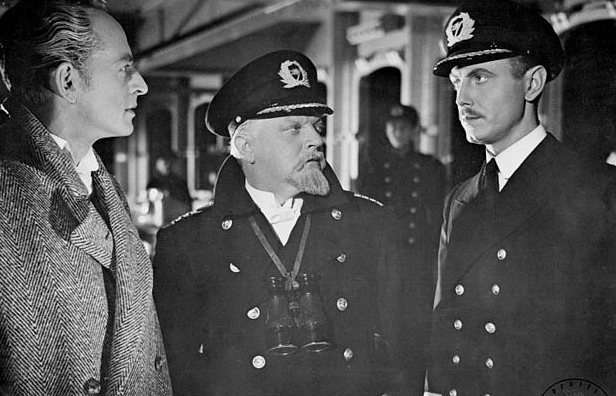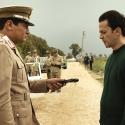With the smoke from Julian Fellowes' upcoming Titanic mini-series for ITV becoming visible over the horizon, Channel 5 nipped in with this startling new spin on the tale of the doomed liner. It's not widely known that when the Nazis were riding high in the early part of World War Two, they hit upon a plan to turn the Titanic story into a blockbuster propaganda film, designed to throw contempt and ridicule over Britain's ruling elite.
Using a variety of film historians and critics from Germany, Britain and the USA, as well as the recently rediscovered production diaries kept by the film's art director, The Nazi Titanic offered intriguing glimpses into the value the Nazis placed on propagandist film-making, as well as on the way Hitler's regime viewed the British. Joseph Goebbels, the Third Reich's Minister of Propaganda, considered Britain to be "a sham democracy ruled by plutocrats" (not much change there then). The Nazi film would use the Titanic, with its upper decks versus lower decks class structure, as the perfect metaphor for a Britain being driven to destruction by its entrenched ruling elite.
 From his experiences with making anti-Semitic films like Jew Süss, Goebbels had learned that dramatised stories were more effective at seizing the popular imagination than documentaries, so bags of creative licence would be taken with Titanic. The narrative was cast as a stark fable of rampant capitalism versus the proletariat. It opened with a scene in which J Bruce Ismay (pictured above in movie), chairman of the White Star Line which operated the Titanic, addressed a room full of shareholders, telling them that their holdings would rocket in value as the ship broke the transatlantic speed record. Caution would be thrown to the winds to achieve that objective, with the ship's captain to be incentivised by bonus payments for every hour by which he broke the record.
From his experiences with making anti-Semitic films like Jew Süss, Goebbels had learned that dramatised stories were more effective at seizing the popular imagination than documentaries, so bags of creative licence would be taken with Titanic. The narrative was cast as a stark fable of rampant capitalism versus the proletariat. It opened with a scene in which J Bruce Ismay (pictured above in movie), chairman of the White Star Line which operated the Titanic, addressed a room full of shareholders, telling them that their holdings would rocket in value as the ship broke the transatlantic speed record. Caution would be thrown to the winds to achieve that objective, with the ship's captain to be incentivised by bonus payments for every hour by which he broke the record.
To bring this fiendishly cunning concept to fruition, Goebbels had recruited his favourite film-maker, 38-year-old Herbert Selpin, who had already pleased the great propagandist with a couple of successful action movies. Goebbels was determined to out-do Hollywood, and no expense would be spared for the Titanic project. The boat would, as it were, be pushed out, to the tune of 4 million Reichsmarks (about £100m). Selpin hurled himself into the spirit of the operation by ordering enormous studio sets to be built in Berlin as well as a 20-foot replica of the Titanic for the sinking scenes, while also demanding the use of a full-sized ship for exterior sequences.
All his wishes were granted, which didn't alter the fact that a curse seemed to loom over the project. When they lugged the model Titanic and truckloads of equipment to a lake near Berlin to shoot the sinking, their efforts were thwarted by appalling weather and technical problems. When the crew moved to the Baltic coast where they'd been given a real live ocean liner, the Cap Arcona, to play with, the shooting schedule was thrown into chaos by incompetent actors and the drunkenness of German servicemen who'd been drafted in to play supporting roles. Selpin launched into a tirade against the German military and the whole Nazi war effort, but was denounced to the authorities in Berlin by his friend and the film's scriptwriter, Walter Zerlett-Olfenius. He was flung into a Gestapo prison cell, where he was found hanged the following morning (bad news reaches the Titanic's bridge, pictured below).
 Goebbels hired a new director and the project ground on, but by the time he watched a cut in December 1942, the mood in Germany had turned from blaring triumphalism to Stalingrad-induced gloom, lit by the flashes of Allied bombs falling on the Fatherland. Goebbels grasped that scenes of terrified passengers drowning at sea had suddenly become symbolic not so much of Britain but of the state of the Reich, and the film was scrapped. In a hideous postscript, days before the German surrender almost 5,000 concentration camp inmates died in the destruction of the Cap Arcona, which was being used as a death ship by the SS. That was three times more than on the Titanic.
Goebbels hired a new director and the project ground on, but by the time he watched a cut in December 1942, the mood in Germany had turned from blaring triumphalism to Stalingrad-induced gloom, lit by the flashes of Allied bombs falling on the Fatherland. Goebbels grasped that scenes of terrified passengers drowning at sea had suddenly become symbolic not so much of Britain but of the state of the Reich, and the film was scrapped. In a hideous postscript, days before the German surrender almost 5,000 concentration camp inmates died in the destruction of the Cap Arcona, which was being used as a death ship by the SS. That was three times more than on the Titanic.
The Nazi Titanic did enjoy a sort of ghostly resurrection. Some of its special effects footage later appeared in the 1958 British film A Night to Remember, a documentary-like account of the loss of the Titanic. This wasn't widely advertised, as you can imagine.
Watch Revealed: The Nazi Titanic on Demand 5















Add comment